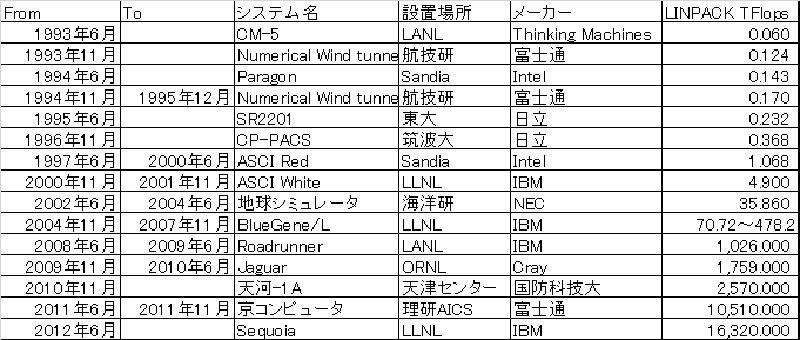"Sequoia" ranked first in the 39th Top500 as a third-generation BlueGene supercomputer
Table 1 List of supercomputers ranked No. 1 in the successive Top500 (1st to 39th). Over the past 19 years, LINPACK performance on top supercomputers has increased by a factor of 27,200
Sequoia is the third generation BlueGene supercomputer developed by IBM. Figure 2 shows the die photo and specifications of the BG/Q CPU chip.
BG/Q's processor chip is made with IBM's 45nm SOI process, and integrates 18 processor cores, 32MB of L2 cache, 2-channel DRAM controller, and a router that connects chips in one chip. are doing.
The BG/Q chip is made with IBM's Cu-45 technology, has a chip size of 360mm2 and integrates 1.47B transistors. This LSI is made with Silicon on Insulator (SOI) technology, and since an insulator is sandwiched between the transistor and the silicon substrate, the parasitic capacitance of the transistor is small. In addition, it used a high-performance semiconductor process developed by IBM to replace aluminum (Al), which was common at the time, for wiring with copper (Cu), which has low resistance and allows a large amount of current to flow.

The CPU chip has 18 processor cores, but 16 cores are used for application calculation processing, and the other core is the core that runs the OS. The other core is a redundant core for allowing defects and increasing yield. In addition, the core connection is variable, and if there is only one defective core, it can be eliminated regardless of the position, and the chip as a whole can be made into a completely good product.
Then, Embedded DRAM (eDRAM) is used to create a common L2 cache for all CPU cores of 32MB.
The processor clock is 1.6GHz, and each core can perform 8 floating point operations per cycle, so the chip's peak computing performance is 1.6G x 8 x 16 (cores) = 204.8GFlops. And the power consumption at this time is 55W. The router of the interconnect network, which is a separate chip in the K computer, is also integrated in the CPU chip, and even including the power consumption of the router, the power consumption is about half that of the K computer. As a result, Sequoia achieves more than double the performance/power ratio of the K computer.
(Next time will be posted on March 4th)
 notebook-laptop
notebook-laptop






